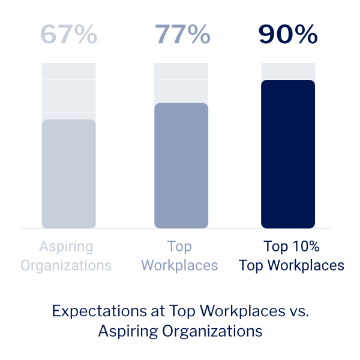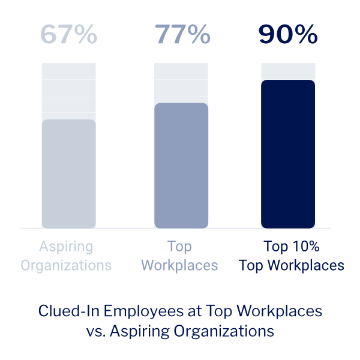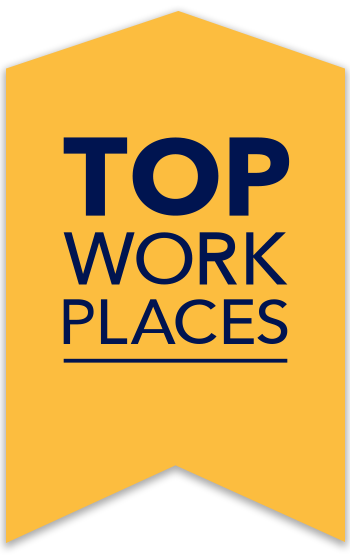Like it or not, every organization has a culture. Some are intentional, some accidental. Leaders of the nation’s Top Workplaces believe in the power of a strong culture, and they prioritize it, day in and day out. They know that creating a workplace culture where employees are highly engaged is a strategic advantage — and one their competitors can’t replicate.
What is organizational culture?
Workplace culture consists of an organization’s unique and collective beliefs, perceptions, values, and behaviors. It was defined in the 1980s as “the way we do things around here.” Established and driven by senior leaders, there is a close relationship between leadership and organizational culture. And while you can copy a great business strategy, it’s impossible to copy a great workplace culture.
Leadership culture
Leadership and organizational culture are directly related. That’s why it’s essential to ensure alignment between the two. Leaders’ interaction with each other and their teams is central to leadership culture, from problem solving and decision making to company direction, values, and appreciation. To determine the impact your leadership has on organizational culture, ask:
- Do your leaders have a positive impact on your workplace culture?
- Are your leaders striving to develop engaged, high-performance teams?
- Do leaders and managers understand the importance of leadership, especially when it comes to company culture and employee experience?
Why is organizational culture important?
Employee engagement is the outcome of a healthy workplace culture. The company is at risk when there are cracks and weaknesses, from employee turnover to decreased productivity and lost revenue.
Our research shows that Top Workplaces achieve almost double the average U.S. engagement rate. That’s because the leaders at these award-winning organizations invest in driving a people-first culture. They know the relationship between leadership and organizational culture helps to:
- Improve employee engagement
- Increase motivation and performance
- Build your company brand
- Strengthen leadership development programs
- Raise the importance of brand reputation among employees
- Boost employee well-being and minimize burnout
- Improve employee retention rates
What are organizational leaders?
All leaders can influence their organization’s culture and employee experience. They run the show and need to ensure all employees have the opportunity to develop professionally, set goals, share feedback, and receive recognition. Coaching, mentoring, and listening will help leadership ensure all programs are in place and running effectively.
The relationship between leadership roles and organizational culture
How does leadership influence organizational culture? Leaders play a significant role in driving a people-first culture. They’re also responsible for supporting culture and affecting change when necessary. With qualities of great leadership, Top Workplaces research shows that leaders can improve employee engagement and influence workplace culture by ensuring the company:
- Operates and lives by strong values.
- Builds confidence in the company’s direction.
- Inspires healthy interdepartmental cooperation.
- Nurtures genuine employee appreciation and meaningful work.
- Is well-informed about important decisions.
- Performs efficiently and well.
- Encourages inclusion, new ideas, and different points of view.
Nine ways leaders impact organizational culture
The relationship between leadership and organizational culture impacts just about everything, but these are some of the most significant ways good leaders support a people-first culture and healthy employee experience.
1. Establish and set expectations
The impact of leadership on organizational culture can be felt as early as the hiring process. Setting expectations is part of the employee value proposition. Sudden changes can be painful, and organizational culture is impacted when this happens.
Leaders need to communicate roles and responsibilities clearly and then meet those expectations. Our employee engagement research shows that Top Workplaces are successful at setting expectations. Employees at these organizations respond more positively to this survey statement:
“This job meets the expectation I had when I started.”

2. Core values
Company values are a powerful declaration of your intentions for your organization’s culture. And in an always-changing environment, they are the glue that holds a workplace together. Strong values keep your organization moving forward, while weak ones threaten its success.
Leadership and corporate culture connect employees to the organization’s mission and vision. It is leadership’s role to establish meaningful values that resonate with all levels of the organization. Leaders must also communicate regularly, apply company values to decision making, and model them daily.
3. Observe for insights into workplace culture
Employee insights help leaders understand where the culture stands and set a path for future success. More specifically, employee feedback helps leaders observe employee engagement levels, gain a fresh perspective on what is and isn’t working, and leverage employee voices to find viable solutions.
4. Provide communication and support
Communication is at the core of the relationship between leadership and organizational culture. When employees feel they are well-informed and included in important decisions, they become true partners in the business — and more connected as a result. They’re also more likely to align with your organization when change occurs, even if they disagree.
At Top Workplaces, we refer to this as “Clued-In Employees.” Our research shows award-winning companies — and those in the top decile — respond more positively to the engagement survey statement:
“I feel well-informed about important decisions at this company.”

Communicating important decisions effectively throughout the organization lays the groundwork for successful change and forward growth. Done right, you’ll notice that employees are more receptive to modifications in the workplace. This is especially true if the changes were inspired by employee feedback.
5. Instill a desire to learn and grow
Leaders who believe in the power of people-first cultures also believe in the benefits of employee training and development. They take the time to understand employees’ abilities and interests — and then align those with the organization’s needs. It reinforces self-value for employees and shows them that leadership believes in their growth and professional development, which also boosts well-being and prevents burnout in the workplace.
6. Recognize and appreciate achievements
Celebrating personal and organizational achievements is an excellent way for leadership to reinforce a culture of employee recognition. Appreciation consistently ranks one of the strongest drivers of engagement. It’s also one of the simplest and least expensive ways to impact morale, productivity, and retention.
Who and what leaders celebrate tells employees a lot about the kind of culture that exists and is expected. When leaders model genuine appreciation every day, the result is a workplace culture people want to be a part of and contribute to in every way. Here are some ideas for leaders to consider:
- Encourage and role model a culture of appreciation.
- Take every opportunity to give a sincere compliment or say “thank you.”
- Share customer praise and success stories.
- Acknowledge milestones and celebrate progress.
- Create a gratitude channel and encourage its use.
Learn more: The Importance and Benefits of Employee Recognition
Learn more: Companies That Understand Employee Recognition
7. Reinforce accountability
Accountability is essential to executing a business strategy. Companies operate efficiently and well when leaders successfully drive a culture of accountability. It requires leaders to be transparent with their teams about the standards they need to reach. In addition, the impact of leadership on organizational culture can be seen through:
- Giving employees the resources they need to be successful
- Establishing and tracking goals
- Discussing progress and making adjustments
- Learning from successes and failures
A culture of accountability is most successful when leaders provide clear direction and support. As a result, employees are more likely to meet and exceed expectations.
8. Take action on feedback
Asking for employee feedback is the first step toward building better engagement — but none of that matters unless leaders are willing to listen and take action. After all, that’s when the real work begins. Here are some of the basic steps:
- Give thanks for honest feedback and set expectations for the next steps.
- Uncover focus areas that can impact organizational culture.
- Set goals and define a roadmap for improvement in response to feedback.
- Share and communicate results.
- Take action towards improvement using data-driven insights.
- Measure and evaluate progress.
Learn more: Improve Employee Survey Insights with Top Workplaces
9. Encourage an inclusive workplace
Research shows that diverse, inclusive organizations outperform the competition in profits, cash flow, revenue, and more. But an inclusive culture requires more than building a diverse workforce. To be successful, leaders must be genuinely open and respectful of individual differences.
An inclusive workplace means people have equal opportunities to contribute their ideas and feel a sense of belonging, increasing their commitment to the organization and its goals. Encouraging this during onboarding ensures new employees transition successfully into their new roles.
Learn more: Ethical Leadership in the Workplace
Top Workplaces for leaders
Top Workplaces Awards are based entirely on employee feedback, using industry-leading data and research. The awards highlight organizations across the nation that are creating a desirable work culture, empowering employees, leading their industry with innovation, and forging the movement towards more transparent business practices.
The Top Workplaces Leadership award is given to organizations that lead by example. Explore this and all Top Workplaces awards to learn more about the companies dedicated to making the world a better place to work together.
If your company is proud of its leadership and people-first culture, get recognized for it! Nominate your organization for Top Workplaces, the employer recognition program that offers awards in 60+ regional markets and national awards for culture and industry excellence.

